#maria lionza
Explore tagged Tumblr posts
Text
Maria Lionza, Lady of the spirits and souls.
The cult of the indigenous goddess Yara de la Onza or Maria Lionza in Venezuela, the same spiritualist cult that has spread to other countries such as Colombia, Peru, and Ecuador, ultimately transcends the comprehension of those occultists and sorcerers who do not reside there.
Maria Lionza is cited in a few books. Most define her as a Venezuelan indigenous legend, a female spirit of native origin, or a "local goddess" of spirits and nature. In Venezuela, Maria Lionza is all of these definitions and more. She is a high magic spiritual entity that assists all those who feel isolated, unappreciated, belittled, marginalized, and mistreated. She and all those who oppose the ideas of the system brought by the colonizers: racism, transphobia, homophobia, religious imposition, patriarchy, etc.
Maria Lionza represents the wild, free, indomitable, and matriarchal aspect of Nature. It is the old story of an indigenous woman who rebelled against the religious institution and freed enslaved people. It is the never-written tale of a powerful woman who discovers in her femininity an intimate connection to divinity and, through it, finds the power to lead the rebellion and claim her role until death and beyond.
Between Animas & Spirits
Maria Lionza acts as a liberator of the Animas and souls from purgatory, just as she was a liberator of the indigenous peoples enslaved by the European colonizers.
She is the central character in the spiritist cult of the animas and spirits in Venezuela. Although the term "Animas" has a massive variety of results according to each Latin American country, in the spiritist aspect, it is the term commonly used to refer to those lost souls, martyred souls, and souls that wander aimlessly in pain, either for having committed suicide or murder, for having seriously harmed others, or (following Catholic tradition) for not having received baptism, although today the latter can be referred to more broadly in the aspect of being an anima that did not follow an established religious current or another spiritual path, and simply has no direction of ascension to follow in the afterlife.
Maria Lionza is the leader of her own spiritual court, and contrary to Santa Barbara, another character of great relevance in the spiritualist cults of the region, who appears as a more modern character and is linked to the Catholic people, Maria Lionza represents the indigenous ancestors and pagan warriors of the past, native sorceresses and their pre-colonization magic, nature's herbal and medicinal secrets, and a connection to all the wild animals of which she has been proclaimed queen.
The animas and spirits serve as messengers of Maria Lionza, a queen in the world of spirits and fairies, the latter being very different characters in Latin America from their European version, darker in character and with a very different origin.
Being a Marialioncero, a priest of Maria Lionza, also implies being a sorcerer who agrees with all these spirits that are present, working at their service and charging them through favors. Conquering the world of spirits is a particular task that requires years of training and constant practice. These are esoteric mysteries not found in books and encyclopedias but hidden in plain sight and in constant and changing practice.
The spirits of low light and the animas act as servants of the queen. They come to the sorcerer or the Chaman to agree in exchange for mutual favors, thus being for them a mission to fulfill beyond life, thus allowing them to somehow way to free themselves from the chains and agony of being souls in pain and serve, beyond death, a purpose superior to them, a spiritual entity of greater power, and work shoulder to shoulder with priests, warriors, and sorcerers of the goddess.
Here Below Classes, Books, and More Content about our Goddess
Save Your Spot for my Upcoming Classes:
Maria Lionza, Goddess of Witches CLICK HERE
Herbal Traditional Magic for Protection CLICK HERE
Other Posts Of Mine To Follow The Topic:Maria Lionza: The Queen of Witches & Fairies.Maria Lionza: A Feminist And Indigenous Cult of Latin American Origin.Marialionceros: The Tradition, Cult, and Spiritism of the Goddess Maria Lionza.A Special Post Made by Me for Tess Whitehurst's Blog:
An Introduction to Queen Maria Lionza, Goddess of Witches, and a Ritual in her Honor.
Pre-Order My Book DREAM WITCHERY:
On Llewellyn Page Click Here
On AMZN Click Here
On Barnes & Noble Click Here
On Bookshop Org Click Here
11 notes
·
View notes
Text
youtube
The Legend of Maria Lionza 🇻🇪
4 notes
·
View notes
Video
youtube
O ASSUSTADOR CULTO DE MARIA LIONZA (QUIBAYO) - CULTOS MACABROS
0 notes
Video
youtube
Maria Lionza - Rubén Blades - Midi File (OnlyOne)
0 notes
Video
youtube
Willie Colon & Ruben Blades - Maria Lionza mas musica
0 notes
Note
no sé mucho de otros países pero acá hay varias leyendas venezolanas y algunos mitos tmb recopilados. cada uno tiene varias versiones pero acá hay una lista de diversos que me sé yo que se me vienen a la cabeza:
La carona (sirena pero MALVADA !!!!!!! MUERAN PESCADORES MUERAN!!!)
el silbón (niño con daddy issues mata al papá y se vuelve el llanero solitario versión espooky) (si escuchas el silbido cerca está lejos, si lo escuchas lejos CAGASTE porque te vio y está cerca tuyo <3)
La sayona (MUERAN HOMBRES INFIELES!!!! MUERAN!!!!!) (en general hay 2 versiones, la que a mí más me gusta es la que dice que era una joven -o varias- asesinada por básicamente un incel casado que no soportaba el rechazo así que ahora se venga de infieles y borrachos-el nombre viene de la prenda que usa, que es el sayo) (la segunda es que es simplemente una mujer loca que mató al esposo pq pensó que le montaba los cuernos y se murió y en general no es tan interesante pero bueno)
Entierros (lucecitas azules que te llevan a tesoros de muertos)
Monstruo del Orinoco (un literal monstruo marino a mitad del Orinoco que si se desborda el río destruirá todo a su paso a ti a tu mamá y a tu perro. casual)
Los momoyes (duendes hijoeputas versión veneco básicamente)
Abuelón (MUERAN PESCADORES-versión mar. damn these margariteños de verdad que les gusta matar a la gente. TMB la isla de coche tipo what's up w that)
Niño de oro (MUERAN PESCADORES- versión río de noche. si te encuentras a ese chamito y lo dejas entrar a tu bote cuando te pida ayuda se vuelve de oro macizo y te hunde. chimbo pues)
Anima sola (le puedes pedir vainas a cambio de algo que te importe burda. hay gente que la venera hay gente que la ve como santera o satánica. yo la veo como una girlboss)
Maria lionza (tiene una literal religión en el país, absolutamente arrecha, básicamente leyenda de una defensora de animales y plantas del Amazonas que rechazó a una anaconda q se quería casar con ella y probablemente tenía albinismo en los ojos y por eso en su tribu indígena la exiliaron pensando que era hija de españoles y que traería mala suerte QUE NO SE NOTE QUE ES DE MIS FAVORITAS)
Juan machete (just a guy) (hizo un pacto con el diablo pero igual just a guy)
Loca luz Caraballo (OTRO BUENÍSIMO) (es un poema que básicamente cuenta la historia de una mujer que enloqueció porque durante la época de la independencia se le murió la hija y sus dos hijos se fueron a pelear con "el hombre a caballo" ajá bolivar y nunca volvieron. ahora vaga por los andes atacando gente y agonizando. de nuevo es un poema BELLÍSIMO y me encanta)
El doctor knoche (UN ALEMÁN QUE HIZO MOMIAS Y ES SUUUUUPER CREEPY HERMANO ES ARRECHISIMOOO)
El hachador perdido (si te lo encuentras CORRE pero de espaldas!!! Con la cara hacia el para que no te persiga. aparte tienes que rezar el credo hasta que no escuches los hachazos)
El enano de la catedral (bro literalmente te pide fósforo para el cigarro y te manda al infierno como consecuencia) (la mejor propaganda Anti tabaco para los criollitos vale)
El carretón fantasma (ÉSTE ES DIVERTIDO básicamente es una carreta q pasa por pueblitos pero plot twist es una carreta del INFIERNO ⁉️⁉️‼️‼️‼️ y el conductor es el DIABLOOO‼️‼️⁉️⁉️‼️⁉️⁉️‼️)
La bola de fuego (BOLA DE FUEGO BABY SIMPLEMENTE SE VE ARRECHÍSIMO LOCOOOOO) (hay más q eso pero simplemente se ve cool) (ah y hay un pana tmb en algunas versiones de fuego q la persigue con un lazo) (aparte ella es única y especial pq si ke rezas te persigue más)
Animas de guanare (CORO PERO VERSIÓN FANTASMITA WOOOOOOOO)
La chinigua (MARGARITA IT'S BACK AT IT AGAIN 🔥🔥🔥🔥🔥 es como la sayona pero VERSIÓN PECES BABEY🔥🔥🔥🔥🔥🔥)
Cerro autana (mito indígena acerca de los tepuyes que son un ecosistema muy importante del país que no existe en ninguna otra parte del mundo) (ta cool)
Waraira repano (otro mito indígena pero ésta vez es acerca del ÁVILA WOOOOOOOOOO🫓🫓🫓🫓🔥🔥🔥🔥🔥🔥🔥🔥🔥)
Mula maneada (no al maltrato animal: la leyenda)
El encadenado de michelena (pana sencillo que simplemente te JODE SI TE ACERCAS A LOS CEMENTERIOS WOOOO🔥🔥🔥🔥)
Caribay y las 5 águilas blancas (leyenda de las únicas montañas con nieve del país y de cómo llegaron a tener nieve en un primer lugar- merideños be winning)
Brujas chupasangre (MARGARITA OTRA VEZ y también los orientales salieron suuuuper basados pq son básicamente 🔥🔥🔥VAMPIRAS FURRAS 🔥🔥🔥 que te matan al niño a base de anemia WOOOOOOOOOO)
Gallina fantasma (el pollito pío y la gallina con RECORD GENOCIDA) (Anzoátegui knows it)
María angula (tengo entendido que este tmb es de ecuador CREO. pero es básicamente la mejor propaganda para que la gente se ponga a aprender a cocinar)
y bueno!!! esas son algunas que me acuerdo!!!!! creo que me pasé un poquito pero me encantan las leyendas venecas desde que tengo memoria hasta el punto de que las uso de inspiración en mis propias historias y arte.
espero que sirva de algo pq enserio son tantas y tan variadas y tan divertidas de ver que un post de Tumblr solito no le hacen justicia
estoy usando ésto para tmb poner algunas páginas de las versiones que conocía de algún lado lol. es un ganar-ganar aquí. pero yo suelo leer son libros de leyendas de latam o de Venezuela pues. los libros escritos por gente de la zona son los más entretenidos)
igual pregúntale a gente de diversos países y de diversas sub culturas pq leyendas como la creación del ser humano de los inca es muy diferente a leyendas de creación de los wayuu por ejemplo
disfruta :)
se que no es tu cosa, pero soy una estudiante y estoy tratando de collectar mitos y leyendas de latino america. sabes lugares o libros o algo donde pueda encontrar los cuentos? el internet no tiene mucho, y cuando hay son en paginas que no confio.
!!!
373 notes
·
View notes
Text
Maria Lionza, Lady of the spirits and souls.
The cult of the indigenous goddess Yara de la Onza or Maria Lionza in Venezuela, the same spiritualist cult that has spread to other countries such as Colombia, Peru, and Ecuador, ultimately transcends the comprehension of those occultists and sorcerers who do not reside there.
Maria Lionza is cited in a few books. Most define her as a Venezuelan indigenous legend, a female spirit of native origin, or a "local goddess" of spirits and nature. In Venezuela, Maria Lionza is all of these definitions and more. She is a high magic spiritual entity that assists all those who feel isolated, unappreciated, belittled, marginalized, and mistreated. She and all those who oppose the ideas of the system brought by the colonizers: racism, transphobia, homophobia, religious imposition, patriarchy, etc.
Maria Lionza represents the wild, free, indomitable, and matriarchal aspect of Nature. It is the old story of an indigenous woman who rebelled against the religious institution and freed enslaved people. It is the never-written tale of a powerful woman who discovers in her femininity an intimate connection to divinity and, through it, finds the power to lead the rebellion and claim her role until death and beyond.
Between Animas & Spirits
Maria Lionza acts as a liberator of the Animas and souls from purgatory, just as she was a liberator of the indigenous peoples enslaved by the European colonizers.
She is the central character in the spiritist cult of the animas and spirits in Venezuela. Although the term "Animas" has a massive variety of results according to each Latin American country, in the spiritist aspect, it is the term commonly used to refer to those lost souls, martyred souls, and souls that wander aimlessly in pain, either for having committed suicide or murder, for having seriously harmed others, or (following Catholic tradition) for not having received baptism, although today the latter can be referred to more broadly in the aspect of being an anima that did not follow an established religious current or another spiritual path, and simply has no direction of ascension to follow in the afterlife.
Maria Lionza is the leader of her own spiritual court, and contrary to Santa Barbara, another character of great relevance in the spiritualist cults of the region, who appears as a more modern character and is linked to the Catholic people, Maria Lionza represents the indigenous ancestors and pagan warriors of the past, native sorceresses and their pre-colonization magic, nature's herbal and medicinal secrets, and a connection to all the wild animals of which she has been proclaimed queen.
The animas and spirits serve as messengers of Maria Lionza, a queen in the world of spirits and fairies, the latter being very different characters in Latin America from their European version, darker in character and with a very different origin.
Being a Marialioncero, a priest of Maria Lionza, also implies being a sorcerer who agrees with all these spirits that are present, working at their service and charging them through favors. Conquering the world of spirits is a particular task that requires years of training and constant practice. These are esoteric mysteries not found in books and encyclopedias but hidden in plain sight and in constant and changing practice.
The spirits of low light and the animas act as servants of the queen. They come to the sorcerer or the Chaman to agree in exchange for mutual favors, thus being for them a mission to fulfill beyond life, thus allowing them to somehow way to free themselves from the chains and agony of being souls in pain and serve, beyond death, a purpose superior to them, a spiritual entity of greater power, and work shoulder to shoulder with priests, warriors, and sorcerers of the goddess.
Here Below Classes, Books, and More Content about our Goddess
Save Your Spot for my Upcoming Classes:
Maria Lionza, Goddess of Witches CLICK HERE
Herbal Traditional Magic for Protection CLICK HERE
Other Posts Of Mine To Follow The Topic:Maria Lionza: The Queen of Witches & Fairies.Maria Lionza: A Feminist And Indigenous Cult of Latin American Origin.Marialionceros: The Tradition, Cult, and Spiritism of the Goddess Maria Lionza.A Special Post Made by Me for Tess Whitehurst's Blog:
An Introduction to Queen Maria Lionza, Goddess of Witches, and a Ritual in her Honor.
Pre-Order My Book DREAM WITCHERY:
On Llewellyn Page Click Here
On AMZN Click Here
On Barnes & Noble Click Here
On Bookshop Org Click Here
3 notes
·
View notes
Text
On “Dead” Cultures and Closed Spiritual Practices: Why Colonialism Is Still A Problem.
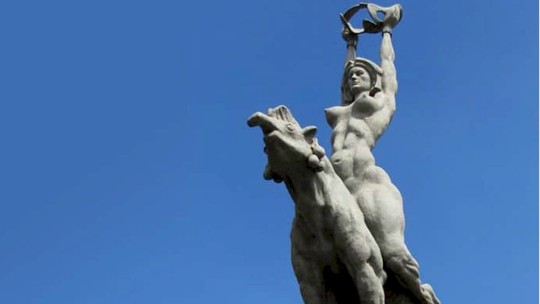
Let me start this by saying that, as far as my knowledge of Paganism and Polytheism as a whole goes, I’m what the internet witch community calls a “Baby Witch”. I’m stating this out of the gate because I know there will be lots of people, including witches who have more experience on the craft than me, who might decide to ignore what I have to say based on that fact alone, stating that I’m not knowledgeable enough to give my opinion about this.
Here’s the kicker: I’m a ‘baby witch’, yes, but I’m also a twenty-six year old Venezuelan woman. I’m an adult. I’m Latina. I’m a Christian-raised Pagan,but I’m also a Latinoamerican woman over all other things including that. I grew up on this culture, these are my roots. It is because of this background than I’m writing this post today.
Looking through the “Paganism” and “Witchcraft” tags of this website, I’ve seen a few posts throwing indigenous deities and spirits’ names around on lists alongside deties of open cultures. Yes, you can know better by doing your own research and not going by what just a random Tumblr user wrote on one post (as I hope its the case with everyone on this website), but the fact that pagan beginners are still getting fed misinformation is still worrisome to me.
There’s nothing like reading a so-called expert putting Ixchen (Maya), Xolotl (Nahuatl) and Papa Legba (Vodou) on the same damn list as Norse, Hellenic and Kemetic deities and tagging it on the tags aimed at beginners who might not know better to truly ruin your morning. I’m not mentioning user names here: If you know then you know.
To quote @the-illuminated-witch on her very good post about Cultural Appropriation:
“Cultural appropriation is a huge issue in modern witchcraft. When you have witches using white sage to “smudge” their altars, doing meditations to balance their chakras, and calling on Santa Muerte in spells, all without making any effort to understand the cultural roots of those practices, you have a serious problem.
When trying to understand cultural appropriation in witchcraft, it’s important to understand the difference between open and closed magic systems. An open system is one that is open to exchange with outsiders — both sharing ideas/practices and taking in new ones. In terms of religion, spirituality, and witchcraft, a completely open system has no restrictions on who can practice its teachings. A closed system is one that is isolated from outside influences — usually, there is some kind of restriction on who can practice within these systems.”
A counter-argument I’ve seen towards this when someone wants to appropiate indigenous deities and spirits is to use the “dead culture” argument: Extinct cultures are more eligible for use by modern people of all stirpes. It is a dead culture and dead religion. It would be one thing if some part of the culture or religion was still alive, being used by modern descendants, but the culture died out in its entirety and was replaced, right? They were all killed by colonization, they are ancient history now, right?
Example: “If white people are worshipping Egyptian deities now, then why can’t I worship [Insert Aborigen Deity Here]?”
To which I have two things to say:
Ancient Egypt’s culture was open and imperialistic, meaning they wanted their religion to be spread. This is why Kemetism is not Cultural Appropriation, despite what some misinformed people might tell you. Similar arguments can also be made for the Hellenic and the Norse branches of Paganism, both practiced by people who aren’t Greek/Norse.
Who are you to say which cultures are “dead” and which are not?
Religious practices such as Vodou and Santería certainly aren’t dead, not that it keeps some Tumblr users from adding Erzuli as a “goddess” on their Baby Witch post, something that actual Vodou practitioners have warned against.
Indigenous cultures such as the Maya and the Mapuche aren’t dead, despite what the goverment of their countries might tell you. The Mapuche in particular have a rich culture and not one, but two witchcraft branches (The Machi and the Kalku/Calcu). Both are closed pagan practices that the local Catholic Church has continuously failed to assimilate and erase, though sadly not for lack of trying:
“The missionaries who followed the Spanish conquistadors to America incorrectly interpreted the Mapuche beliefs regarding both wekufes and gualichos. They used the word wekufe as a synonym for ideas of the devil, demons, and other evil or diabolical forces. This has caused misunderstanding of the original symbolism and has changed the idea of wekufe right up to the present day, even amongst the Mapuche people.”
For context, the Wefuke are the Calcu’s equivalent of the Familiar, as well as reportedly having more in common with the Fae than with demons anyway.
This and other indigenous religions are Closed because it is wrong for foreigners to just come and take elements from marginalized groups whom are still fighting to survive and that they weren’t born into. To just approppiate those things would be like spitting in their faces, treating them and their culture like a commodity, a shiny thing, a unique thing to be used like paint to spruce up your life or be special.
I know some of you are allergic to the word “Privilege”, but on this situation there really ain’t a better word to explain it. You weren’t born here, you don’t know what it is like, you are only able to see the struggle from an outsider’s point of view.
If a belief or practice is part of a closed system, outsiders should not take part in it. And with how many practices there are out there which are open for people of all races, there is really no excuse for you to do it.
Why Colonization Is Not “Ancient History”
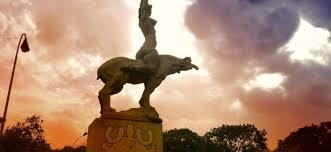
If you have kept reading all this so far, you are probably wondering “Ok, but what does Colonization has to do with any of this?”
The answer? Everything.
With the general context of culture appropriation out of the way, let me tell you about why the whole “dead culture” argument rubs me the wrong way: Here in Venezuela, we have a goddess called Santa Maria de la Onza, or Maria Lionza for short, whom’s idol statue I have been using to illustrate this little rant. If you happen to know any Spanish, you might recognize the name as a derivative of Santa Maria, aka the Virgin Mary, and you are mostly correct: Her true indigenous name is theorized to have been Yara.
And I say “theorized” because it is a subject of hot debate whether she was really ever called that or not: Her original name, the name by which she was adored and worshipped by our ancestors, might have been forever lost to history.
That’s the legacy of colonization for you: Our cultures were stolen from us, and what they couldn’t erase they instead tried to assimilate. Our ancestors were enslaved, their lands and homes stolen, their artwork and literary works destroyed: The Maya and the Aztec Empire were rich in written works of all kinds, ranging from poetry to history records to medicine, and the Spaniards burned 99% of it, on what is probably one of the most tragic examples of book burning in history and one that people rarely ever talk about.
People couldn’t even worship their own gods or pass their knowledge of them to their children. That’s why Maria Lionza has such a Spanish Catholic-sounding name, and that’s why we can’t even be sure if Yara was her name or not: The Conquistadors couldn’t steal our goddess from us, so they stole her name instead. Catholics really have a thing with trying to assimilate indigenous goddesses with the Virgin Mary, as they tried to do the same with the Pachamama.
On witchy terms, I’d define Maria Lionza as both a deity and a land spirit: Most internet pages explaining her mention the Sorte mountain as her holy place, but it is more along the lines that she is the mountain.
You’d think that, with Venezuela and other Latinoamerican countries no longer being colonies, we’d be able to worship our own deities including her, right?
As far as a lot of Catholics seem to think and act, apparently we are not.
The Catholics here like to go out of their way to shame us, to call us “cultists”, to ostracize us, with a general call to “refrain from those pagan beliefs” because they go against the Catholic principles. Yes, the goddess with the Catholic-sounding name, a name she happens to share with a Catholic deity, apparently goes “against Catholic principles”. You really can’t make this shit up. (Linked article is in Spanish)
This is just an act of colonization out of many, of not wanting to stop until the culture they want to destroy is gone. Don’t believe for a second that this is really their God’s will or anything like that, they are just trying to finish what years of enslavement and murder couldn’t. They might not be actively killing us anymore, but they still want us dead.
So no, colonization is not some thing that has long passed and now only exist on history textbooks: It is still happening to this day. It is by treating it as old history that they can keep doing it, and it is by pushing the narrative that our indigenous cultures are “dead cultures” that they try to erase our heritage.
Because we are not dead. We are still here, we are alive, we have survived and we’ll keep on surviving, and our gods and goddesses are not yours to take.
¡Chao! 🐈
#pagan#paganism#religion#culture#latino#latinoamerica#colonization#witch#baby witch#witchcraft#witchblr#Maria Lionza#colonialism#venezuela#brujeria#polytheism#witchcore#mapuche#vodou#nahuatl#history#cultural appropiation
2K notes
·
View notes
Photo
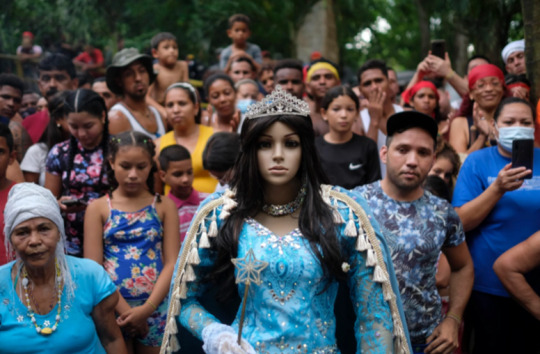
A statue of Maria Lionza stands in front of followers of her cult during their annual gathering at Sorte Mountain in Venezuela’s Yaracuy state, Monday, Oct. 11, 2021.
(AP Photo/Matias Delacroix)
67 notes
·
View notes
Text
Pedro Centeno Vallenilla .(1899-1988) Sketch for a slave in ‘Maria Lionza’ picture. María lionza is a Venezuelan goddess

Pedro Cebreno Vallenilla: Nude Study (1940s)
240 notes
·
View notes
Text
Inauguran Plaza María Lionza en Quibayo estado Yaracuy
Inauguran Plaza María Lionza en Quibayo estado Yaracuy #09Oc #enbreve #news
Este domingo se inauguró la plaza María Lionza en Quibayo, estado Yaracuy, acto que estuvo encabezado por el vicepresidente Sectorial de Comunicación, Cultura y Turismo, Freddy Ñáñez, el ministro del Poder Popular para la Cultura, Ernesto Villegas, y el gobernador de la entidad, Julio León Heredia. Ñáñez, señaló que «El día de hoy es la absoluta representación de Venezuela. Un crisol de colores…
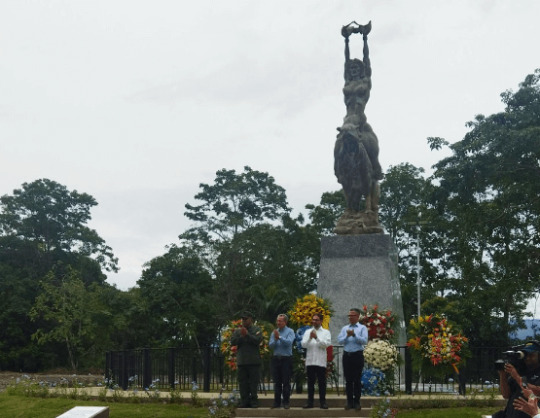
View On WordPress
2 notes
·
View notes
Text
For Women’s Day: Maria Lionza
(abbreviated Maria de la onca, Maria of the tapir) is the central figure in a widespread indigenous religion in Venezuela. The cult of María Lionza is syncretic blend of African, indigenous and Catholic beliefs. She is revered as a goddess of nature, love, peace and harmony, and has followers throughout Venezuelan society, from small villages to Caracas, where in 1951 a monument by Venezuelan sculptor Alejandro Colina was erected in her honour. She rides a tapir, and holds a female pelvis, symbol of fertility. I passed the monument on the highway several times; it has a powerful, primordial presence.
The main place of worship is a cave in Sorte mountain, also known as Cerró Maria Lionza Natural Monument. According to the legend, Maria, daughter of a local indigenous chief, merged with the mountain when attacked by an anaconda. I visited the cave, full of offerings - flowers, candles, incense, cigars, food, alcohol. The glow of candles from the cave is visible from the highway. She’s an unofficial symbol of Venezuela.

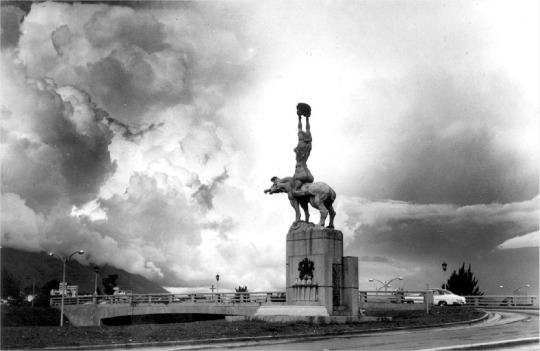

31 notes
·
View notes
Text
at the maria lionza initiation like oh you got involved bc of a deep abiding connection to la señora? oh cool im here so i can get this idol the career he deserves and also all the stuff you said that too
gonna get into brujeria to boost ten’s career
7 notes
·
View notes
Link
Together with the spirits of delinquents who died in streets fights or police operatives (Ferrándiz, 2004b),since their appearance in the early nineties it is the African and Viking spirits who attract most of the younger marialionceros of all the spirits in the pantheon, dominating the practice today. In Sorte mountain just as in urban ceremonies, especially in the groups dominated by younger materias, the spirits of the Indians, liberators, doctors or peasants who were predominant for at least the last fifty years have given way to the Africans and Vikings, both composing a spiritist and bodily cluster difficult to discern.
3 notes
·
View notes
Photo

Who is María Lionza?
#maria lionza#goddess#venezuela#religion#spirituality#indigenous#anthropology#south america#central america
1 note
·
View note